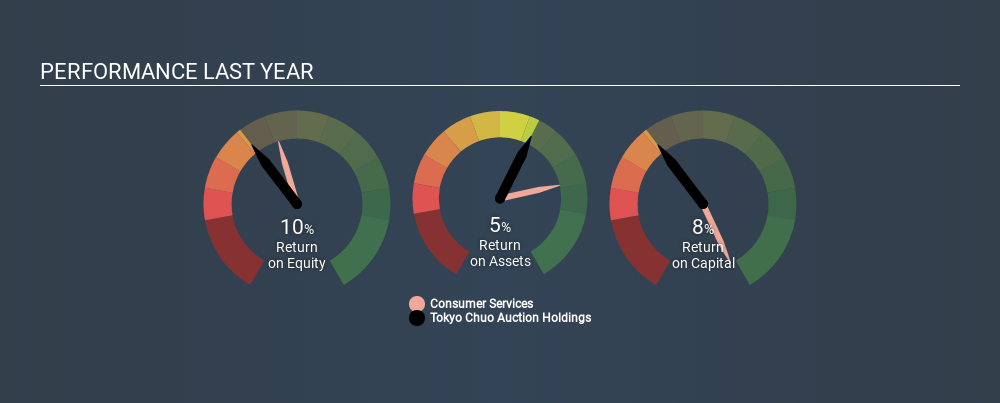- Hong Kong
- /
- Consumer Services
- /
- SEHK:1939
Tokyo Chuo Auction Holdings Limited (HKG:1939) Might Not Be A Great Investment

Today we are going to look at Tokyo Chuo Auction Holdings Limited (HKG:1939) to see whether it might be an attractive investment prospect. In particular, we'll consider its Return On Capital Employed (ROCE), as that can give us insight into how profitably the company is able to employ capital in its business.
First, we'll go over how we calculate ROCE. Second, we'll look at its ROCE compared to similar companies. And finally, we'll look at how its current liabilities are impacting its ROCE.
Return On Capital Employed (ROCE): What is it?
ROCE measures the amount of pre-tax profits a company can generate from the capital employed in its business. All else being equal, a better business will have a higher ROCE. In brief, it is a useful tool, but it is not without drawbacks. Author Edwin Whiting says to be careful when comparing the ROCE of different businesses, since 'No two businesses are exactly alike.
So, How Do We Calculate ROCE?
Analysts use this formula to calculate return on capital employed:
Return on Capital Employed = Earnings Before Interest and Tax (EBIT) ÷ (Total Assets - Current Liabilities)
Or for Tokyo Chuo Auction Holdings:
0.075 = HK$23m ÷ (HK$552m - HK$245m) (Based on the trailing twelve months to September 2019.)
Therefore, Tokyo Chuo Auction Holdings has an ROCE of 7.5%.
See our latest analysis for Tokyo Chuo Auction Holdings
Is Tokyo Chuo Auction Holdings's ROCE Good?
When making comparisons between similar businesses, investors may find ROCE useful. Using our data, Tokyo Chuo Auction Holdings's ROCE appears to be significantly below the 11% average in the Consumer Services industry. This could be seen as a negative, as it suggests some competitors may be employing their capital more efficiently. Setting aside the industry comparison for now, Tokyo Chuo Auction Holdings's ROCE is mediocre in absolute terms, considering the risk of investing in stocks versus the safety of a bank account. Investors may wish to consider higher-performing investments.
Tokyo Chuo Auction Holdings's current ROCE of 7.5% is lower than its ROCE in the past, which was 33%, 3 years ago. This makes us wonder if the business is facing new challenges. You can see in the image below how Tokyo Chuo Auction Holdings's ROCE compares to its industry. Click to see more on past growth.

When considering ROCE, bear in mind that it reflects the past and does not necessarily predict the future. ROCE can be deceptive for cyclical businesses, as returns can look incredible in boom times, and terribly low in downturns. ROCE is, after all, simply a snap shot of a single year. If Tokyo Chuo Auction Holdings is cyclical, it could make sense to check out this free graph of past earnings, revenue and cash flow.
What Are Current Liabilities, And How Do They Affect Tokyo Chuo Auction Holdings's ROCE?
Liabilities, such as supplier bills and bank overdrafts, are referred to as current liabilities if they need to be paid within 12 months. Due to the way ROCE is calculated, a high level of current liabilities makes a company look as though it has less capital employed, and thus can (sometimes unfairly) boost the ROCE. To counter this, investors can check if a company has high current liabilities relative to total assets.
Tokyo Chuo Auction Holdings has total assets of HK$552m and current liabilities of HK$245m. Therefore its current liabilities are equivalent to approximately 44% of its total assets. Tokyo Chuo Auction Holdings's middling level of current liabilities have the effect of boosting its ROCE a bit.
What We Can Learn From Tokyo Chuo Auction Holdings's ROCE
Unfortunately, its ROCE is still uninspiring, and there are potentially more attractive prospects out there. But note: make sure you look for a great company, not just the first idea you come across. So take a peek at this free list of interesting companies with strong recent earnings growth (and a P/E ratio below 20).
If you like to buy stocks alongside management, then you might just love this free list of companies. (Hint: insiders have been buying them).
If you spot an error that warrants correction, please contact the editor at editorial-team@simplywallst.com. This article by Simply Wall St is general in nature. It does not constitute a recommendation to buy or sell any stock, and does not take account of your objectives, or your financial situation. Simply Wall St has no position in the stocks mentioned.
We aim to bring you long-term focused research analysis driven by fundamental data. Note that our analysis may not factor in the latest price-sensitive company announcements or qualitative material. Thank you for reading.
About SEHK:1939
Tokyo Chuo Auction Holdings
An investment holding company, provides auction, artwork sales, and related services in Hong Kong and Japan.
Mediocre balance sheet very low.
Market Insights
Community Narratives


